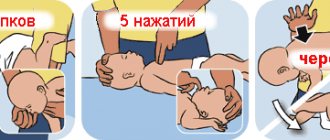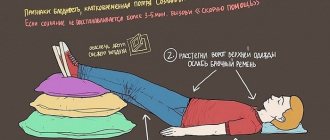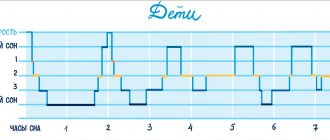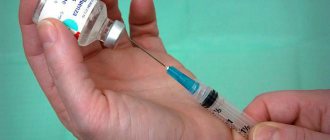What should be the location of the folds on the legs?
Newborns and children in the first year of life have special skin folds in the buttocks and thighs. Ideally, when folding a child's legs together, the inguinal and knee folds should mirror each other (create one horizontal line).
If the folds on the legs are asymmetrical, this can be either a congenital developmental feature that does not pose any threat to the baby’s health, or a signal of the development of pathology. Therefore, if asymmetry of the folds on the legs is detected, it is necessary to consult a doctor who will examine the child and carry out the necessary diagnostics.
Newborn's eyes
A few minutes after birth, most babies open their eyes and begin to look carefully at everything. Newborns can see, but they cannot focus their eyes or follow objects for long. Due to swelling of the eyelids, some children cannot open their eyes wide. You can help your baby with the “doll eyes” reflex: if you put your baby in an upright position, his eyes will open wide.
Some parents become very concerned when they see the white part of one or both of their baby's eyes covered in blood. This is a subconjunctival hemorrhage, which is associated with childbirth and blood getting under the membranes of the eyeball. This is a harmless condition, similar to bruising of the skin, which disappears after a few days. It absolutely does not indicate that the child’s eyes were damaged during childbirth.
Parents often want to know what color their baby's eyes will be. Most babies are born with bluish-gray eyes, but the pigmentation of the iris (the colored part of the eye) gradually changes, usually becoming constant between 3 and 6 months of age. If a baby's eyes are brown at birth, that color will remain that way.
How to detect asymmetry of skin folds?
Asymmetry of the folds on the legs can be detected in a child with straightened legs. The folds on the legs of infants should be symmetrical both in front and behind. If, when examining a child at home, there is a suspicion of asymmetry, it is necessary to contact a pediatric orthopedic doctor who will examine the child, determine whether there really is asymmetry, and determine its cause. You should also make an unscheduled appointment with an orthopedist if the child does not have one fold on his leg, one of the baby’s buttocks is larger than the other, or the folds on the baby’s legs are uneven.
What to do if there is no asymmetry of the folds on the baby’s legs?
If there is no asymmetry of the folds on the child’s legs, this is not a reason to refuse regular monitoring of the baby’s developmental characteristics and preventive examinations by doctors. Routine examinations of the child by an orthopedist should be carried out:
- at 1 month;
- at 3 months;
- in six months;
- in year.
Thus, an examination by an orthopedist at 1 month is aimed at identifying possible congenital or acquired orthopedic pathologies. When examined at 3 months, the doctor has the opportunity to diagnose a number of abnormalities that cannot be determined at 1 month (for example, muscular torticollis). An orthopedic examination at 6 months is aimed at checking the child's motor skills. During an orthopedic consultation, which is carried out for a child at the age of one year, the ability of the child’s musculoskeletal system to cope with increasing loads is analyzed and the child’s preparation for walking is assessed.
Etiology and pathogenesis of the development of hallux valgus
There are congenital and acquired foot deformities.
With a “true” congenital deformity, the cause lies in a change in the shape and relative position of the bones of the distal parts of the lower extremities during intrauterine development. The disease, caused by a genetic defect or pathologies of pregnancy, in this case is usually detected in the first months after birth. The most severe variants of this pathology are the so-called. “vertical ram” and “rocker foot”, requiring surgical correction.
Acquired hallux valgus develops due to imperfection (underdevelopment) of the ligaments and tendons of the legs, as well as low muscle tone (hypotonia). The causes are often some diseases of the musculoskeletal system, and in some cases - wearing uncomfortable or soft shoes that do not adequately support the foot. As a rule, developmental deviations become noticeable at the age of 10-12 months, that is, when the child first begins to try to walk independently.
This orthopedic pathology is more common in children with a weakened body, which in turn may be due to a lack of necessary nutrients (hypotrophy) during embryogenesis, prematurity and frequent acute respiratory viral infections at an early age.
Important: in almost 80% of cases, the cause of foot development pathology is dysplasia (structural disorder) of connective tissue! Among the reasons for its appearance are poor ecology and low-quality food products. Disorders of bone tissue, as well as muscles and ligaments, always accompany a disease such as rickets
Hallux valgus often occurs when there is excessive load on the ligamentous apparatus of the foot against the background of excess body weight (obesity) in the child. Researchers attach great importance to genetic (family) predisposition, endocrine diseases (hypothyroidism, diabetes) and osteogenesis disorders
Disorders of bone tissue, as well as muscles and ligaments, always accompany a disease such as rickets. Hallux valgus often occurs when there is excessive load on the ligamentous apparatus of the foot against the background of excess body weight (obesity) in the child. Researchers attach great importance to genetic (family) predisposition, endocrine diseases (hypothyroidism, diabetes) and osteogenesis disorders.
The cause of secondary static-dynamic pathological changes in the legs can also be:
- cerebral palsy;
- polio;
- polyneuropathy;
- muscular dystrophy.
Hallux valgus in children is possible after prolonged wearing of a plaster cast, as well as after traumatic sprains. Often the pathology develops against the background of dysplasia or congenital dislocation of the hip.
Finally, the foot tends to become deformed if adults try to teach a child to walk too early.
Due to insufficient muscle tone (hypotonia), the arch flattens under the baby’s own weight. Stretching and weakening of the muscular-ligamentous apparatus of the lower leg and toes makes it impossible to hold the foot in a normal (physiological) position.
Treatment of dysplasia
Hip dysplasia is a defect in the development of the acetabulum, which houses the head of the femur. A complication of dysplasia can be dislocation of the hip joint.
Symptoms of dysplasia include:
- asymmetry of folds on the baby’s legs;
- instability of the hip joint;
- limited abduction of the affected hip joint;
- asymmetry of the legs in an infant.
The diagnosis of dysplasia is made by an orthopedic surgeon. At the appointment, the doctor examines the baby, studies the features of his development and, if necessary, prescribes additional tests (X-rays, ultrasound). After diagnosis, the orthopedist prescribes an individual treatment regimen.
Treatment for dysplasia usually includes:
- fixation of the hip joints in their physiological position;
- salt heating pads on the hip joints;
- physiotherapeutic procedures;
- special exercises for the hip joint;
- massotherapy.
Massage for hip dysplasia usually lasts 15-20 minutes. Moreover, the first 5-7 minutes are occupied by a general massage, and the rest of the time by stroking and rubbing problem areas. Massage for dysplasia ensures blood flow to the tissues located around the joint and also helps restore the functionality of the joint.
Gymnastics for dysplasia can be done at home. As a rule, the doctor recommends a set of exercises, which includes raising and bending the legs, bringing the heels to the buttocks and simulating crawling.
Careful monitoring of the baby’s development from the very moment of his birth is extremely important, as it helps to detect various pathologies in time. And timely treatment and compliance with the recommendations of an orthopedic surgeon can prevent the development of serious complications in a child.
0
0
2
Article rating:
3.86 out of 5 based on 7 ratings
Author: Popov Evgeniy Vladimirovich
Orthopedist-traumatologist, pediatric orthopedist-traumatologist. Highest category. Work experience 11 years.
Treatment methods for hallux valgus
Treatment of hallux valgus depends on the stage of development of the disease. Only a specialist can choose a truly effective option. It is worth considering commonly used types of fight against a bunion on the big toe.
Operational
Surgery helps to quickly and permanently get rid of hallux valgus. It has the following options:
- traditional;
- laser
For quite a long time, surgery has been used to treat a protruding bone. The traditional option involves the use of general anesthesia. The operation itself is performed using a large number of instruments and is accompanied by blood loss. Upon completion, the patient is given a plaster cast. For this reason, the person remains immobilized for about 2 weeks. The recovery period itself takes up to 2 years and is accompanied by some discomfort.
Laser treatment is now widely used. This operation is performed through small incisions in the area of the lump, so it leaves only barely noticeable scars. The procedure itself lasts about an hour and is performed under local anesthesia.
Laser stone removal can be of the following types:
- exostectomy involves the removal of excess bone and soft tissue, immediately after which the foot takes on its proper appearance;
- laser osteotomy partially excises the phalanx of the thumb;
- Resection arthroplasty is used in complex cases and involves excision of valgus deformity and replacement of the joint with a prosthesis.
The decision on the need for surgery and the type is made only by the doctor based on the results of a detailed diagnosis of the patient. In any case, laser treatment is more gentle and allows you to return to work after two weeks. Leg mobility is restored the very next day after surgery.
Medication
Drug treatment for hallux valgus is reduced to relieving swelling, inflammation and pain. It will not be possible to remove the lump without surgery, but ointments such as Voltaren or Indomethocin can quickly relieve unpleasant symptoms.
Doctors may also prescribe anti-inflammatory drugs, for example, Nimulid. This remedy is used internally in a course and helps to get rid of pain in the big toe area for a long time.
The use of Meloxicam and Movali gives very good results, but these drugs should only be used with a doctor's prescription. This will allow you to get rid of pain safely and quickly.
Folk remedies
Folk remedies can also help improve your condition for a while. They are used for various diseases. There are recipes aimed specifically at relieving inflammation with hallux valgus. The most popular are:
- Dandelion infusion based on iodine. 100 g of dried flowers should be filled with iodine and left for 4-5 days, then applied in the form of a grid to the problem area for 2 weeks.
- Compresses with propolis. A small piece of propolis should be kneaded in your hands and applied to the bump overnight. Repeat for a month.
- Salt and iodine bath. Every evening, it is recommended to steam your feet in warm water with the addition of 2 tablespoons of salt and 10–15 drops of iodine.
- Burdock wraps. Fresh burdock leaves should be moistened with turpentine and applied to the pine cone.
- Cabbage and honey compress. First, honey is applied to the leg, then a mashed cabbage leaf is applied and secured with a bandage. The compress should be applied before bedtime.
- Homemade ointment based on iodine and aspirin. You need to add 5 aspirin tablets to a bottle of iodine and apply it to your feet every 3 days for a month.
These methods will not help get rid of the bone, but they relieve inflammation quite well. Before starting such treatment, possible allergic reactions must be excluded.











